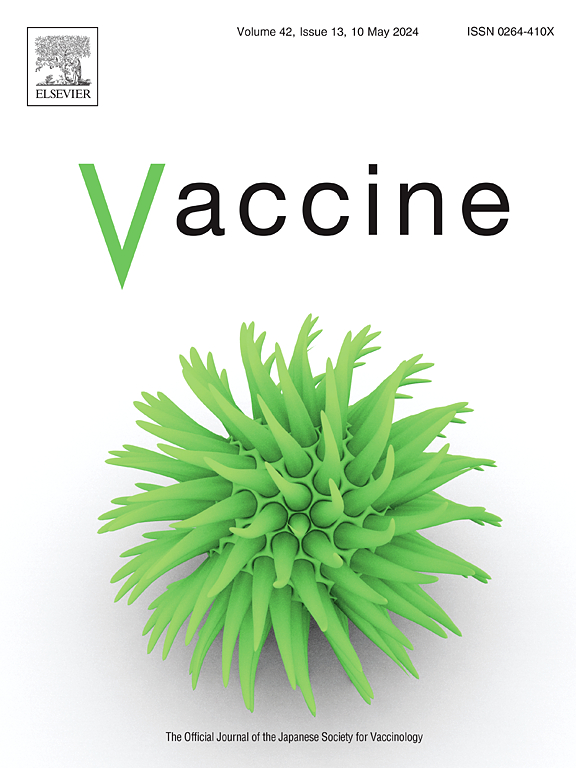表达全套SARS-CoV-2结构蛋白的细胞外囊泡疫苗的免疫应答
IF 4.5
3区 医学
Q2 IMMUNOLOGY
引用次数: 0
摘要
为了开发一种新型的基于细胞外囊泡(EVs)的COVID-19疫苗,我们设计了包含全套SARS-CoV-2结构蛋白的EVs。因此,具有稳定的野生型刺突蛋白骨架的SARS-CoV-2变体BA.2或BA.4/5刺突蛋白(S)的受体结合域(RBD)在293T细胞中稳定表达,核衣壳蛋白(N) c末端与CD63、膜(M)和包膜(E)蛋白融合。然后,从细胞中收集细胞死亡相关的ev,并评估SARS-CoV-2结构蛋白的表达。结果证实,刺突融合蛋白、N、M和E三聚体成功加载到ev中。在小鼠肌肉注射模型中,接种50 μg ev后,增强注射后对S产生显著的IgG抗体反应,并中和S伪vsv的进入。25或50 μg ev初始注射小鼠抗核衣壳抗体有效增加,在加强剂量后进一步增加。所有剂量(10、25或50 μg) ev增强免疫小鼠均可产生针对S和N蛋白的记忆性CD4+ TH1细胞和CD8+ TC细胞。此外,在接受50 μg ev的增强免疫小鼠中,T细胞对M和E肽的反应增强。总之,这项工作证明了表达SARS-CoV-2蛋白的ev作为通用候选疫苗的可行性,可能为新出现的SARS-CoV-2变体和未来的大流行提供保护。本文章由计算机程序翻译,如有差异,请以英文原文为准。
Immunologic responses to an extracellular vesicle-based vaccine expressing the full suite of SARS-CoV-2 structural proteins
In an attempt to develop a novel extracellular vesicles (EVs)-based vaccine against COVID-19, we designed EVs harboring a full set of SARS-CoV-2 structural proteins. Thus, the receptor-binding domain (RBD) of spike protein (S) of SARS-CoV-2 variant BA.2 or BA.4/5 with the stabilized wild type spike protein backbone, nucleocapsid protein (N) C-terminally fused with CD63, membrane (M), and envelope (E) proteins were stably expressed in 293T cells. Then, cell death-associated EVs were collected from the cells and evaluated for the expression of SARS-CoV-2 structural proteins. As a result, it was confirmed that trimers of spike fusion protein, N, M, and E were successfully loaded in the EVs. In an intramuscular injection model of mice, the inoculation of 50 μg EVs resulted in significant IgG antibody responses to S after the booster injection and neutralized the entry of S-pseudotyped VSVs. Anti-nucleocapsid antibodies were efficiently increased in mice primarily injected with 25 or 50 μg EVs, showing further increased values after booster dosages. Memory CD4+ TH1 cells and CD8+ TC cells against S and N proteins was generated in mice that received a booster-immunization with all dosages (10, 25, or 50 μg) of EVs. Additionally, T cells responses against M and E peptides were increased in booster-immunized mice that received 50 μg of EVs. Taken together, this work proved feasibility of EVs expressing SARS-CoV-2 proteins as a universal vaccine candidate, potentially offering protection against emerging SARS-CoV-2 variants and future pandemics.
求助全文
通过发布文献求助,成功后即可免费获取论文全文。
去求助
来源期刊

Vaccine
医学-免疫学
CiteScore
8.70
自引率
5.50%
发文量
992
审稿时长
131 days
期刊介绍:
Vaccine is unique in publishing the highest quality science across all disciplines relevant to the field of vaccinology - all original article submissions across basic and clinical research, vaccine manufacturing, history, public policy, behavioral science and ethics, social sciences, safety, and many other related areas are welcomed. The submission categories as given in the Guide for Authors indicate where we receive the most papers. Papers outside these major areas are also welcome and authors are encouraged to contact us with specific questions.
 求助内容:
求助内容: 应助结果提醒方式:
应助结果提醒方式:


